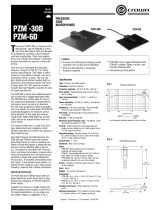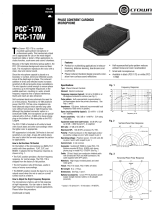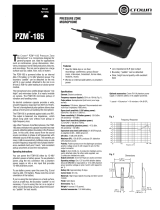
PHASE COHERENT
CARDIOID MICROPHONE
PCC160
he AKG/Crown
PCC160 (Phase
Coherent
Cardioid
®
) is a surface-
mounted half - supercardioid
microphone intended for professional
applications on stage floors, lecterns,
conference
tables, and news desks—wherever
improved gain-
before-feedback and articulation are important.
Similar to the Pressure Zone Microphone
®
(PZM
®
), the PCC is designed to be used on a
relatively large boundary surface. Unlike the PZM,
the Phase Coherent Cardioid uses a subminiature
supercardioid mic capsule. Its directional polar
pattern improves gain-before-feedback, reduces
unwanted room noise and rejects sounds from the
rear. Surface-mounting creates a “half-supercardi-
oid” polar pattern and increases directivity 3 dB.
Since the microphone capsule is placed on a
boundary, direct and reflected sounds arrive at
the diaphragm in-phase. This coherent addition
of direct and reflected waves increases sensitivity
6 dB and prevents phase cancellations. The mic
capsule is small enough to ensure phase coher-
ency up to the highest frequencies in the audible
spectrum, resulting in a wide, smooth frequency
response free of phase interference. Clarity and
reach are also enhanced.
Self-contained electronics eliminate the need
for an in-line preamp box. The PCC160 can be
phantom powered directly from the console or
other remote power source providing 12 to 48
volts. If battery power is required, a battery supply
unit can be inserted anywhere in the mic line right
up to the console or mixer. A “bass tilt” switch
allows the user to tailor the low-end response for
particular applications.
Thanks to its low profile and black finish, the
microphone becomes almost invisible in use. A
side-mounted connector complements the form
factor of the PCC160, allowing the unit to be
placed effectively at the stage edge, at the top of a
lectern or in other tight spots. If desired, the cable
can be hard-wired for bottom entry.
The heavy-gauge, all steel body protects the unit
from accidental abuse. Permanent mounting is
enabled by screw holes in the base. Engineering
attention-to-detail has assured years of trouble-
free use from this reliable microphone.
Capable of withstanding up to 120 dB SPL with-
out distorting, the PCC160 will never overload
in practical use. Its electret condenser capsule
provides a wide, smooth frequency response from
50 Hz to 18 kHz. RFI suppression is included.
Self-noise is low, and sensitivity is very high to
override mixer noise in distant-miking applica-
tions. Output impedance is 150 ohms, balanced.
Features
Industry-standard stage floor microphone
Phase Coherent Cardioid design prevents color-
ation from surface sound reflections
High output overrides mixer input noise
Specifications
Type:
Phase Coherent Cardioid.
Element:
Electret condenser.
Frequency response (typical):
50 Hz to 18,000 Hz at
30 degrees incidence to surface. See Fig. 1.
Polar pattern:
Half-supercardioid (supercardioid in the
hemisphere above the primary boundary).
See Fig. 2 and Fig. 3.
Impedance:
150 ohms nominal (85 ohms actual),
balanced. (Recommended load impedance 1000
ohms or greater.)
Open-circuit sensitivity:
22mV/Pa* (–33 dB re 1
V/Pa*).
Power sensitivity:
–31 dB re 1 milliwatt/Pa*
EIA rating: - 123 dBm .
Equivalent noise level (self noise):
22 dB typical
(0
dB = 0.0002 dyne/cm
2
), A-weighted.
S/N ratio:
72 dB at 94 dB SPL.
Maximum SPL for 3% THD:
120 dB SPL.
Polarity:
Positive pressure on the diaphragm pro-
duces positive voltage on pin 2 with respect to pin
3 of output connector.
Cable:
15-foot, black, two-conductor shielded cable
with Switchcraft TA3F connector and A3M con-
nector.
Operating voltage:
Standard phantom power
:
12 to
48 volts DC positive on pins 2 and 3 with respect
to pin 1.
Safe Operating Temperature:
–10° to +50° C or
+14° to +122° F.
Current drain:
4 mA nominal.
Materials:
All steel body construction.
Finish:
black.
Net weight:
11.5 oz. (326 g).
Dimensions:
See Fig. 5.
Optional accessories:
AKG/Crown PH1A phantom
power supply (one channel, battery or AC-adapter
powered).
*1 pascal = 10 dynes/cm
2
= 10 microbars = 94 dB SPL.
Half-supercardioid polar pattern rejects the
pit orchestra and offers high gain-before-
feedback
Very rugged
Low profile
Fig. 1
Frequency Response
Frequency in Hz
Fig. 2
Vertical Plane Polar Response
1 kHz
200 Hz
4 kHz
Fig. 3
Horizontal Plane Polar Response
1 kHz
200 Hz
4 kHz






